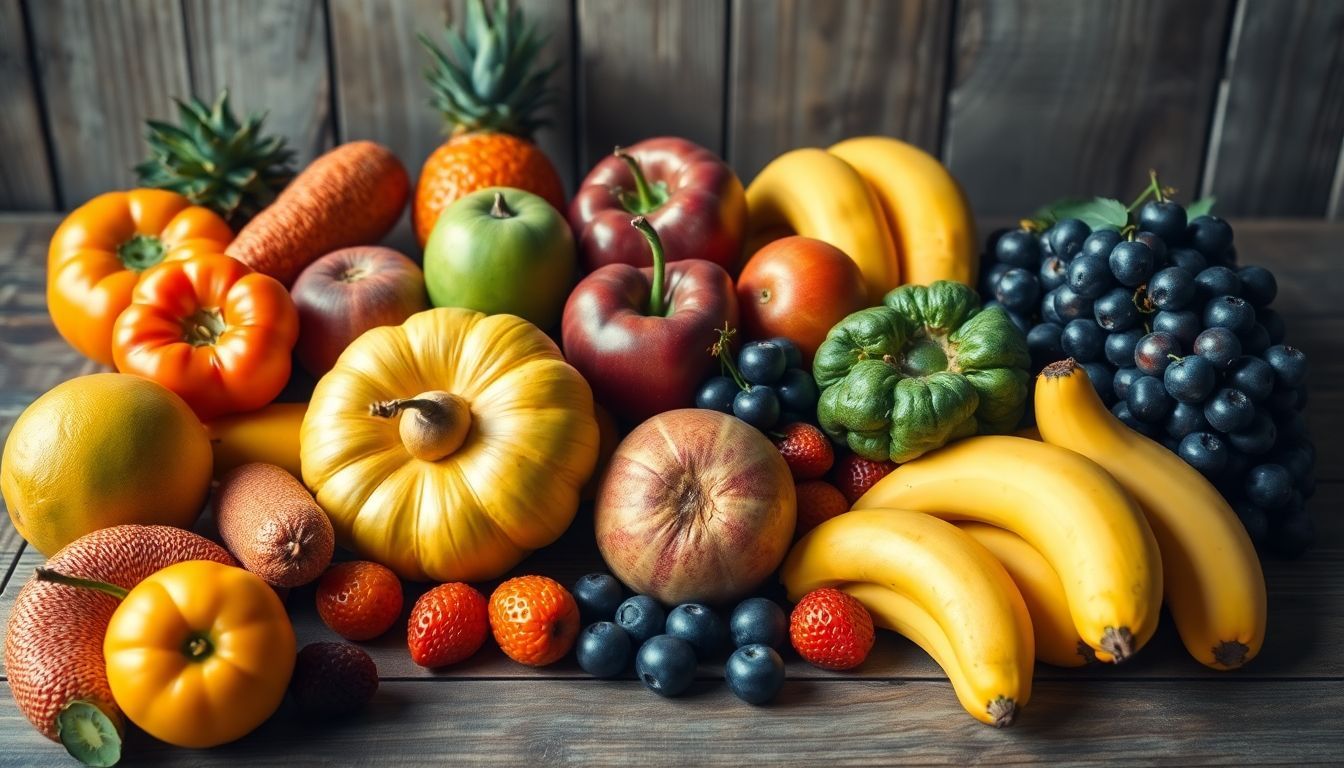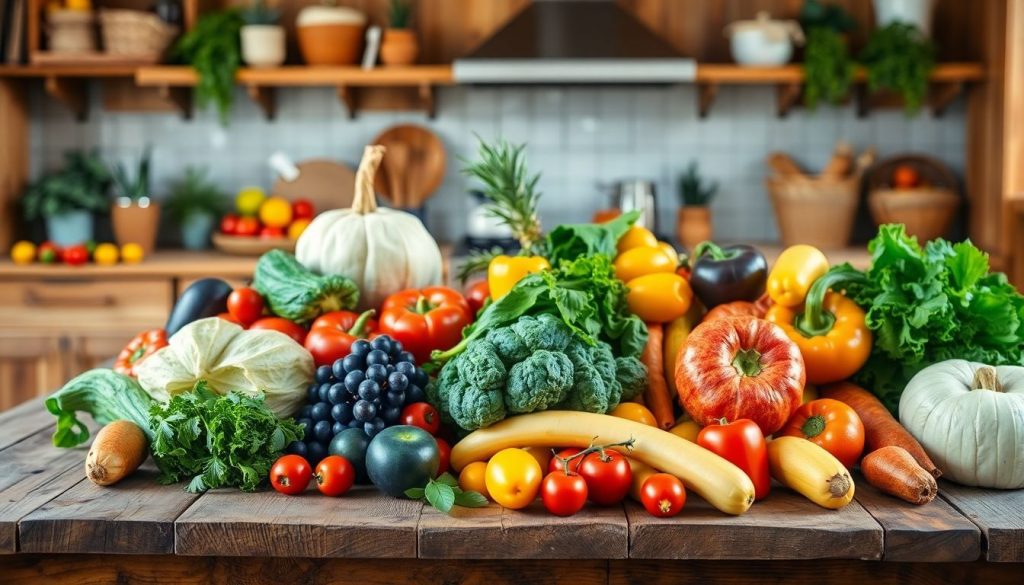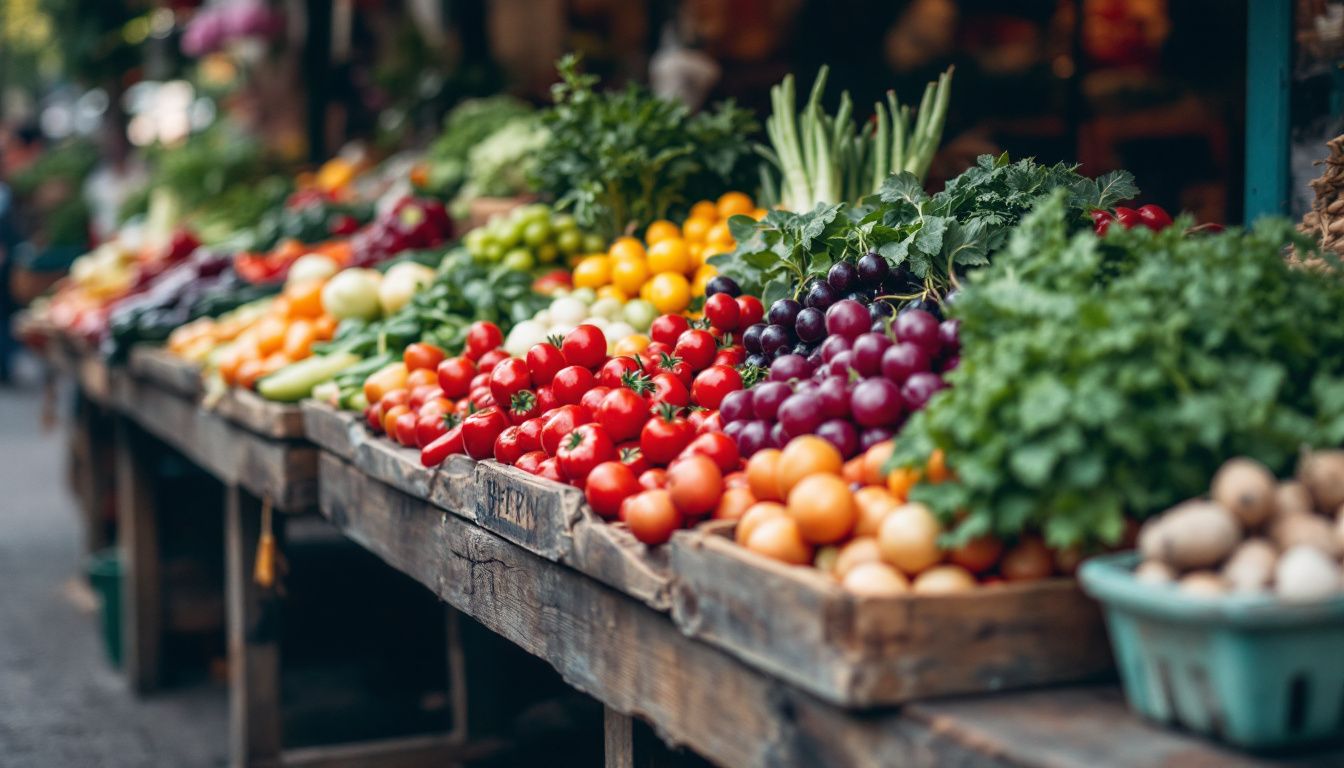Eating healthy can feel confusing with so many choices at the store. Fresh fruits and vegetables offer essential vitamins, minerals, and other nutrients your body needs. This guide highlights the best options to keep you strong and fight off health problems like heart disease or type 2 diabetes.
Thank you for reading this post, don't forget to subscribe!Keep reading for simple tips on picking the healthiest produce!
Key Takeaways
- Add fruits like avocados and berries to your diet. Avocados provide healthy fats, while berries are high in antioxidants and fiber for heart health and cancer prevention.
- Leafy greens like kale and spinach offer vitamin K, A, C, and folate. They improve bone strength and blood pressure while being low in calories.
- Sweet potatoes provide complex carbs for energy and beta carotene for sharp vision. Beets support heart health with their nitrates, boosting circulation and lowering blood pressure.
- Citrus fruits boost immunity with vitamin C—83 mg from an orange or 45 mg from a lemon meets daily needs. Apples aid digestion with fiber while supporting weight management.
- Follow storage tips to keep produce fresh longer: Refrigerate leafy greens unwashed; store potatoes in cool spots; avoid overcrowding items in crisper drawers for airflow.
Top Healthiest Fruits to Include in Your Diet
Fruits are full of vitamins, minerals, and antioxidants. Adding a variety to your meals can boost energy, improve heart health, and support digestion.
Avocado: Packed with healthy fats and vitamins
Avocados are rich in omega-3 fatty acids and healthy monounsaturated fats. A 7-ounce avocado has about 322 calories and 30 grams of fat, giving your body sustained energy. They also contain around 14 grams of fiber, supporting digestion and bowel movements.
These nutritious fruits provide vitamins like E (28% DV) for skin health and Folate (41% DV), which supports cell growth. Eating avocados can boost HDL cholesterol levels—known as good cholesterol—and help regulate blood pressure.
Berries: High in antioxidants and fiber
Berries pack a punch with antioxidants and fiber. Blueberries offer 24% of your daily vitamin K and 22% manganese per cup, while strawberries nearly cover your full daily vitamin C needs.
Raspberries give you 8g of fiber per cup—great for digestive health—and provide 36% of vitamins C and manganese. Goji berries add variety with 15% vitamin C, 42% vitamin A, and even iron at 11% in just an ounce.
These fruits fight oxidative stress and help prevent several types of cancers due to their high antioxidant levels—up to ten times more than other produce. They are versatile too—enjoy them fresh, in smoothies, or as jams without losing much nutrition.
For a healthy diet that supports heart problems or boosts immunity, adding berries is the way to go!
Apples: A versatile fruit rich in nutrients and fiber
A medium apple with its skin has about 4.37 grams of fiber and only 94.6 calories. The fiber, especially pectin, helps improve digestive health and keeps you full longer. Apples are also rich in quercetin, a plant compound known for reducing oxidative stress.
Regularly eating apples may lower the risk of heart disease, diabetes, and some cancers. They also support weight management—a study found apple eaters are 30% less likely to be obese! Grab one as a quick snack or slice it into salads for added crunch and nutrients.
Bananas: A great source of potassium and energy
Bananas offer 3 grams of fiber, potassium, and vitamin B6 in each serving. A single banana has about 89 calories and provides 22.8 grams of carbs, making it a perfect energy boost during the day.
Its low glycemic index (42-58) ensures blood sugar levels stay balanced.
As bananas ripen, their starch turns into natural sugars. Fully ripe ones have more than 16% total sugar content—ideal for a sweet yet healthy snack!
Citrus Fruits: Boost your vitamin C intake
Oranges, lemons, and other citrus fruits are rich in vitamin C. A medium orange gives 83 mg of this key nutrient. Lemons provide 45 mg per fruit, meeting half your daily needs. These fruits help support immune function and fight oxidative stress.
Citrus is easy to add to meals or snacks. Make fresh juices or squeeze lime over stir-fries for extra flavor and nutrients. Their high levels of essential vitamins enhance overall health—including eye health and blood pressure control.
Next up: leafy greens loaded with vital nutrients!

Top Healthiest Vegetables to Prioritize
Vegetables are packed with nutrients that support a healthy body. Choosing the right ones can improve energy, digestion, and overall health.
Leafy Greens: Nutrient-dense options like kale and spinach
Kale is a powerhouse. One cup gives you 684% of your daily value for vitamin K, 206% for vitamin A, and 134% for vitamin C. It’s also packed with fiber and plant compounds that support heart health and fight oxidative stress.
Toss it in soups or make crispy kale chips.
Spinach offers 181% of your daily value for vitamin K per cup. It’s rich in manganese, folate, and essential vitamins like A and C. Add spinach to stir-fries or smoothies to boost nutrients without adding many calories.
Both greens are great for healthy bones and blood pressure.
Broccoli: Loaded with vitamins and minerals
Broccoli is a powerhouse of nutrients. One cup, chopped and boiled, contains 91% of your daily vitamin C and 77% of the vitamin K you need. It also provides 15% folate and 2.2 grams of dietary fiber—all in just 30.9 calories! This cruciferous vegetable supports healthy bones, boosts immune health, and promotes cancer prevention.
Its high levels of plant compounds help fight oxidative stress. Broccoli delivers double the recommended daily amount of vitamin C for glowing skin and better eye health. Add it to stir-fries or soups for an easy way to enrich your diet with essential vitamins and minerals!
Sweet Potatoes: A healthy source of complex carbs and beta carotene
Broccoli strengthens bones, but sweet potatoes fuel your body with energy. One cup of baked sweet potato has 180 calories and 41 grams of carbs, making it a great source of complex carbohydrates.
These carbs digest slowly, helping you stay full longer.
Sweet potatoes are packed with beta carotene, which the body turns into vitamin A. This provides over 200% of your daily value for vitamin A—great for eye health and strong immunity.
They’re also rich in fiber, supporting good digestion and gut health. Perfect roasted or added to stir-fries!
Bell Peppers: High in vitamins A and C
Bell peppers are full of vitamins and goodness. A medium red bell pepper gives 169% of the Reference Daily Intake (RDI) for vitamin C. They also contain a good amount of vitamin A, which supports eye health and overall well-being.
These colorful veggies—red, yellow, orange, and green—are low in calories yet nutrient-rich. Regularly eating them may lower the risk of chronic diseases like heart disease. Add them to stir fries or salads for a delicious crunch while boosting your healthy diet!
Beets: Great for heart health and antioxidants
Rich in nitrates, beets help lower blood pressure and boost heart function. Nitrates convert into nitric oxide, which relaxes blood vessels and improves circulation. This can lead to better exercise performance as well.
One cup of beets provides over one-third of the daily value for folate (vitamin B9), a nutrient that promotes healthy blood flow.
Folate also helps reduce high homocysteine levels linked to heart disease and stroke risk. Beets are packed with antioxidants that combat oxidative stress and protect cells from damage.
Their vibrant pigments give them color and also contain cancer-fighting properties. Drinking beet juice or adding cooked beets to salads makes it easy to enjoy their benefits!

Understanding Carbohydrates in Fruits and Vegetables
Carbohydrates give your body energy, especially for the brain. Fruits and vegetables provide natural sources of these carbs along with fiber, vitamins, and minerals. Sweet potatoes are a good example of complex carbohydrates.
They also deliver beta carotene, which boosts eye health. Green peas offer plant-based protein and both soluble and insoluble fiber for better digestion.
Simple carbohydrates in fruits like bananas break down quickly into glucose. This provides quick energy—a great option before workouts or busy days. High-fiber produce like apples keeps you full longer while aiding digestive health.
Experts suggest at least 130 grams of carbs daily but advise limiting added sugars to under 10% of calories to avoid empty ones—stick with whole foods instead!
Tips for Buying and Storing Fresh Produce
Fresh produce adds vital nutrients to your diet. Picking and storing them the right way keeps them fresh and full of flavor.
- Choose bright, firm produce. Avoid limp leaves or blemished skin as these may spoil faster.
- Keep apples and bananas away from leafy greens. Apples and bananas release ethylene gas, which can make other vegetables decay quickly.
- Store potatoes and sweet potatoes in a cool, dark spot with air circulation. Do not refrigerate them as this changes their texture and taste.
- Refrigerate leafy greens unwashed in zip-top bags to keep them moist and crisp longer.
- Place apples in the coldest part of your fridge, preferably in a plastic bag to lock in freshness.
- Keep winter squash at room temperature in a dry place for months of storage without spoiling.
- Wash berries gently before eating—not before storing—to prevent mold growth.
- Always check seasonal charts from trusted sources like The Environmental Working Group for fresh picks low in pesticide residues.
- Use glass containers or special produce bags to store cut vegetables like bell peppers or taro root for better shelf life.
- Avoid overcrowding fruits like citrus or vegetables like swiss chard in crisper drawers, which need airflow to stay fresh longer.
Conclusion
Eating more fruits and vegetables can improve your health. Choose options like leafy greens, berries, and sweet potatoes for key nutrients. Mix fresh produce into meals to boost vitamins and fiber easily.
Pick organic items from the “Dirty Dozen” list when you can. Small changes lead to big health benefits!
